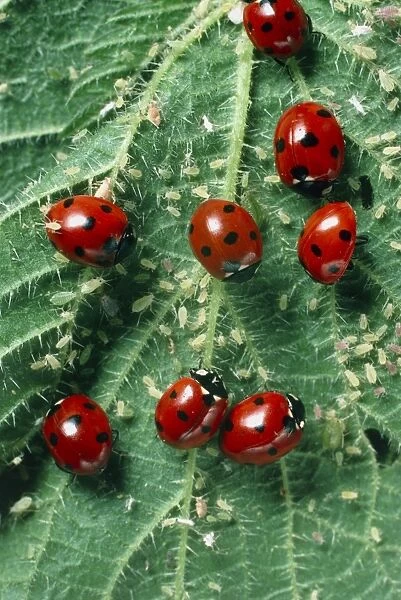Ladybird beetles eating aphids on a nettle leaf
![]()

Wall Art and Photo Gifts from Science Photo Library
Ladybird beetles eating aphids on a nettle leaf
Ladybirds eating aphids. Seven-spot ladybird beetle Coccinella septempunctata, feeding on the large green nettle aphid Microlophium carnosum. This predation is occurring on the leaf surface of a stinging nettle Urtica dioica. Aphids are the ladybirds main food source; this beetle is encouraged by gardeners since aphids are serious pests of flowers, vegetables and some fruit trees. Coccinella septempunctata is about 7mm long, with short antennae, and despite its short legs it is a good runner and a voracious aphid hunter. Seven black spots on the bright red wing covers of the beetle serve to warn ladybird predators that this beetle is itself inedible
Science Photo Library features Science and Medical images including photos and illustrations
Media ID 6461394
© DR JEREMY BURGESS/SCIENCE PHOTO LIBRARY
Aphid Beetle Coccinella Coccinella Septempunctata Insecta Lady Bird Nettle Type Urtica Dioica Stinging Hairs
EDITORS COMMENTS
This print captures a fascinating moment in the world of insects. Ladybird beetles, specifically the Seven-spot ladybird beetle Coccinella septempunctata, are seen feasting on aphids that have infested a nettle leaf. Aphids are notorious pests that wreak havoc on flowers, vegetables, and fruit trees, making them a prime target for these voracious predators. Measuring about 7mm long with short antennae and legs, the Seven-spot ladybird beetle may appear unassuming at first glance. However, its ability to swiftly navigate through foliage and hunt down aphids is truly remarkable. The bright red wing covers adorned with seven black spots serve as a warning to potential predators that this particular beetle is inedible. Gardeners often welcome these beneficial insects into their gardens as they help maintain balance by keeping aphid populations in check. This natural form of pest control ensures healthier plants without relying on harmful chemicals. The intricate details captured in this photograph showcase the delicate interaction between predator and prey within nature's complex web of life. It serves as a reminder of the beauty and efficiency found even in seemingly small-scale ecosystems like a nettle leaf. This stunning image from Science Photo Library not only highlights the wonders of zoology but also provides valuable insights into how different species coexist harmoniously while fulfilling their ecological roles.
MADE IN THE UK
Safe Shipping with 30 Day Money Back Guarantee
FREE PERSONALISATION*
We are proud to offer a range of customisation features including Personalised Captions, Color Filters and Picture Zoom Tools
SECURE PAYMENTS
We happily accept a wide range of payment options so you can pay for the things you need in the way that is most convenient for you
* Options may vary by product and licensing agreement. Zoomed Pictures can be adjusted in the Basket.


